Can My Ecommerce Website Get Cheated With Fake Paypal Money
There are many ways to determine if a website is imitation—here's what nosotros recommend.
The internet is full of websites that are either fake, fraudulent or a scam. Information technology's a sad fact of life. You come across, the evolution of the cyberspace has brought with it a number of extremely convenient advances in the manner we shop, bank, and collaborate with the globe around us. At the same time, that evolution has too given fashion to new risks—new avenues for criminals to rip off the unsuspecting. In 2018 Cybercrime will be a $ane.five trillion industry.
Really, what it all boils down to is fraud. These hackers and cyber criminals are trivial more than new age con men. And the con game is as old equally fourth dimension itself—people have literally been tricking one another since the starting time of time. And in the same vein equally ancient mystics and one-time-fashioned snake oil salesmen, these con-men are later on 1 thing: your money.
Nowadays their tactics tend to involve phishing. Lots and lots of phishing.
What is Phishing?
Phishing is a type of online fraud that involves getting an private or organization to disclose sensitive, sometimes compromising data, under false pretenses that have been expertly manufactured by the attackers. Tailoring your phishing attack to your target is sometimes called spearphishing, it's a form of social applied science. These attacks take several forms, often elaborately combining multiple mediums to create the impression of legitimacy.
What does that mean?
Well, let's look at an instance. An assailant may get-go by sending you a formal looking electronic mail from an address that resembles an official account. It may say something similar, "an attempt to login to your account has been fabricated from another country, please update your password."
In fact, that's exactly how John Podesta, the chairman of Hillary'due south Clinton'south presidential campaign, had his email business relationship compromised.
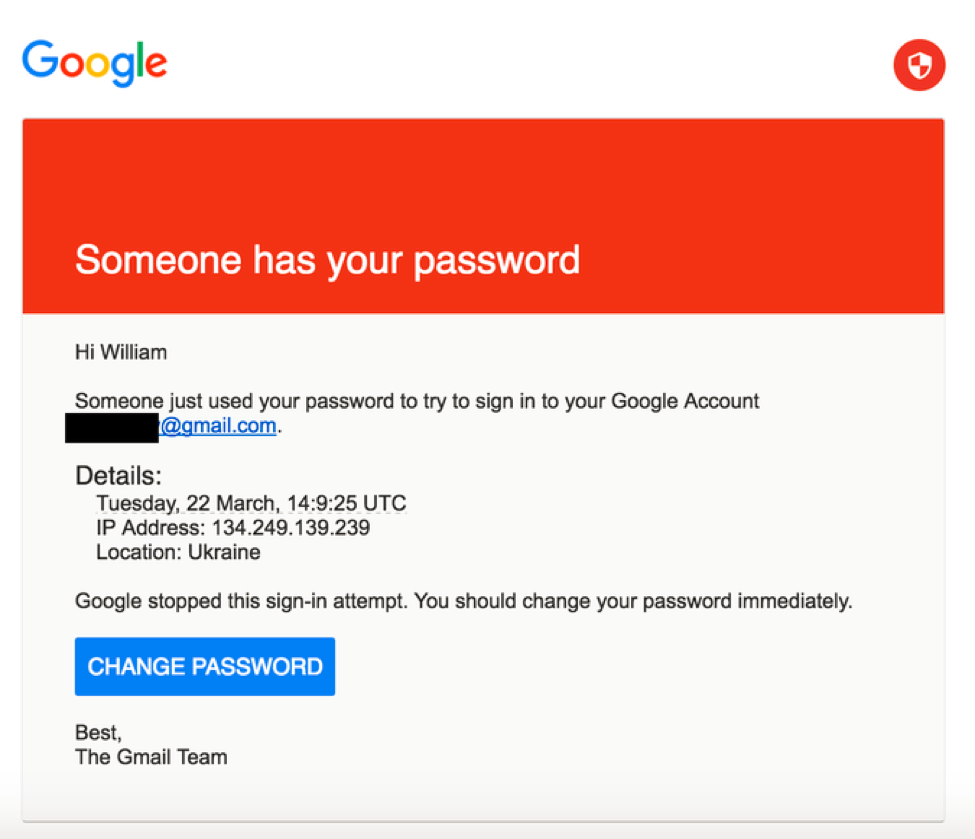
That e-mail included a link to a peculiarly designed page that is a perfect replication of the Google login page. To the untrained eye, it's nigh impossible to tell the fake site from the existent 1. You can see how similar tactics could be used to steal financial information or medical data. Here'south an example of a fake PayPal login screen:
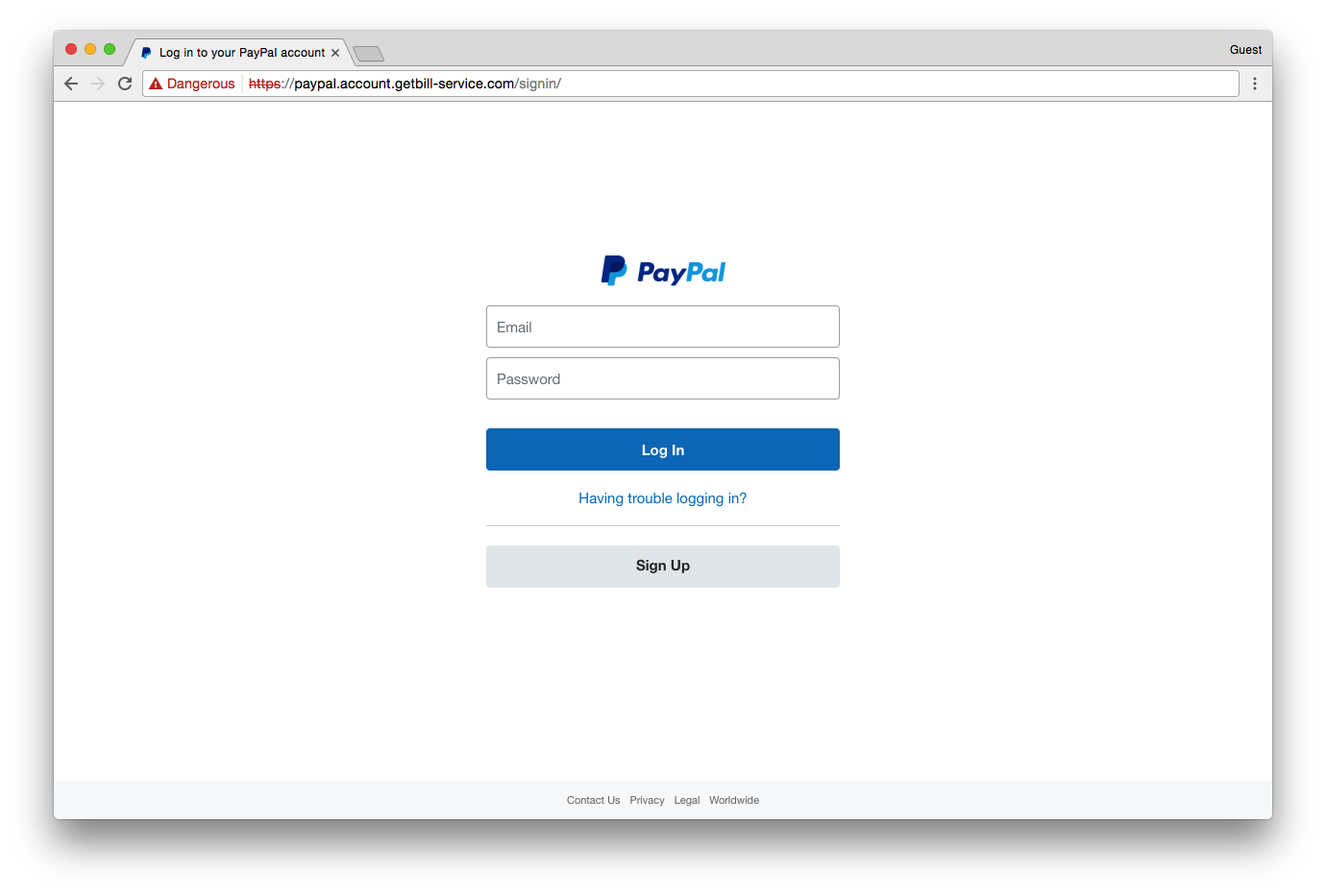 And with the appearance of free SSL services and recent changes to browser indicators, it'south becoming easier than e'er to disguise phishing sites every bit legitimate.
And with the appearance of free SSL services and recent changes to browser indicators, it'south becoming easier than e'er to disguise phishing sites every bit legitimate.
UPDATE: Google has now changed its browser UI to be less misleading.
Other Types of Cyber Attacks to Be Aware Of
Phishing is amidst the near prevalent, simply not the but blazon of attack that yous need to be wary of on the internet. Hither are some examples of other types of internet malfeasance:
- 3rd-Political party Content Injection – The nigh common case of this is over public WiFi hotspots. Have yous ever noticed an affluence of actress ads or pop-ups (on websites that don't normally incorporate them) when you're at the mall or the airport? This is an case of third-party content injection. Because the website lacks SSL, the Internet access provider can inject its own content onto the site. This ways you're not seeing the site as it's intended. And if the third-party has negative intentions, it can inject harmful content.
- Eavesdropping – Similar to phishing, if an attacker knows how, they can overhear on a connexion and steal whatsoever information being transmitted. This underscores the demand for connectedness security—without it, everything you send online can be intercepted and stolen by anyone who wants it.
- Skillful Old-Fashioned Fraud – Ever seen a 20-dollar iPad? Neither accept we. Now, that doesn't mean you won't see websites annunciate them—they just virtually never be. In all likelihood yous're about to wire money to an business relationship in the Philippines. Staring longingly at that low-res image on the popular-up ad is the closest you'll always get to actually owning the tablet.
5 Ways to Decide if a Website is False, Fraudulent, or a Scam
Here are 5 means to decide if a website is fake – plus some additional tips to stay safe online.
1. Pay Close Attending to the URL
You would be admittedly shocked how many people pay little to no attending to the address bar of their browser. This is a huge mistake. The address bar contains a ton of vital information about where you are and how secure you are there. Then go into the habit of occasionally glancing up there whenever you visit a new page.
In fact, nearly of the browsers bide a concept called the Line of Decease. The idea is that a user should never trust anything beneath a certain point on the browser, the and then-called line of death. An aggressor can control everything below the line (and even some things above information technology) so you have to know where to wait for reliable information.
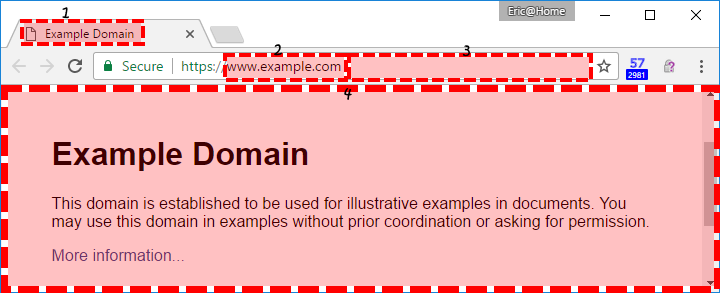
The areas that an assaulter can control are highlighted in crimson and numbered. Permit's go over them really quickly:
- The Favicon – Websites can put whatever icon they want in the tab.
- Domain Proper name – This is part of the URL and it'due south trustworthy, as long as you know what you're looking for (more on that in a second).
- File path/Director – Ditto.
- Web content surface area – This tin be whatever the attacker wants it to be, including a very convincing spoof of a legitimate website.
1 of the chief tactics in phishing is to create a website that is most indistinguishable from the real thing. In order to do this, hackers and cybercriminals have gotten very ingenious in the ways they copy URLs. Betwixt the ability to create sub-domains that mimic real domains and how browsers can confusingly shorten URLs, it'south easy to get duped.
Related: What is Unicode Phishing?
In lodge to know what to look for when examining the URL, you lot need to know how a URL is constructed.

Related: Secure Your Domain & Sub-Domains with a RapidSSL Wildcard Certificate.
At present, armed with that knowledge, always make certain that you know what the actual domain you're on is. Sub-domains tin can be misleading. Here'due south an example of a beginning- and 2nd-level sub-domain that intentionally mimic a domain and TLD:
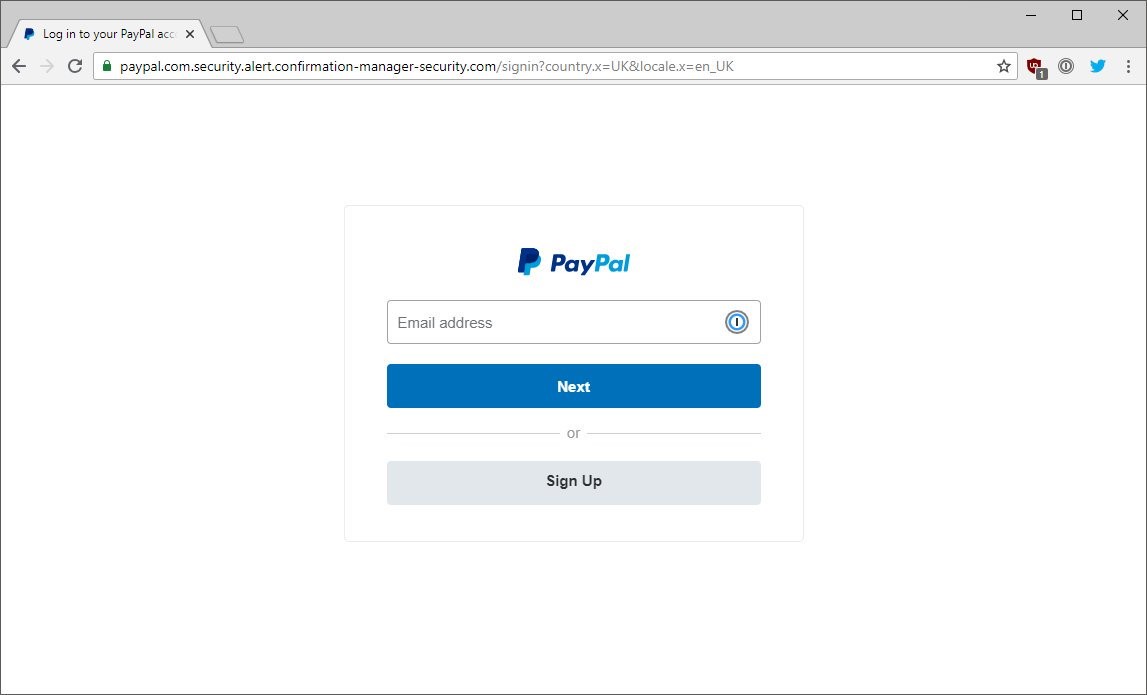
This URL is designed to await like it'south PayPal.com, but if you look closer you'll notice that those are sub-domains, the name of the actual domain is "confirmation-manager-security." Remember, the real domain name appears correct earlier the TLD (east.yard. .com/). This is not really PayPal. This is a phishing site. Notice how information technology nevertheless displays the little green padlock cheers to the employ of an SSL certificate?
That'due south why you e'er have to check the URL.
2. Check Connection Security Indicators
Back to the accost bar. If the last point didn't underscore the importance of this browser feature—this one should drive the betoken dwelling. Within the address bar are several connection indicators that allow you know whether your connection with this website is private. Every bit we mentioned before, it's possible to eavesdrop on connections on the cyberspace.
![]() The cyberspace was built on HTTP, or the hypertext transfer protocol. When HTTP was beginning defined the internet was not used for commercial action. In fact, commercial activity on the internet was actually illegal at the time. The internet was primarily supposed to be a platform for the gratis commutation of information betwixt academia and the regime. Any communication done via HTTP is sent in plaintext and tin exist intercepted, manipulated, stolen—you name it.
The cyberspace was built on HTTP, or the hypertext transfer protocol. When HTTP was beginning defined the internet was not used for commercial action. In fact, commercial activity on the internet was actually illegal at the time. The internet was primarily supposed to be a platform for the gratis commutation of information betwixt academia and the regime. Any communication done via HTTP is sent in plaintext and tin exist intercepted, manipulated, stolen—you name it.
In society to remedy this, SSL or Secure Sockets Layer was developed. SSL was after succeeded by TLS or Transport Layer Security. Today, we colloquially refer to both as SSL.
At whatever charge per unit, HTTP + TLS = HTTPS, which is a secure version of HTTP that prevents communication from being intercepted and read past anyone only y'all and the website yous are connected to. That'southward a lot of data, but what you really demand to know is this:
HTTP = Bad
HTTPS = Good
Never trust an HTTP website with your personal information.
Now, permit's go to connection security indicators. You desire to look for ane of the two post-obit indicators:
The Padlock Icon
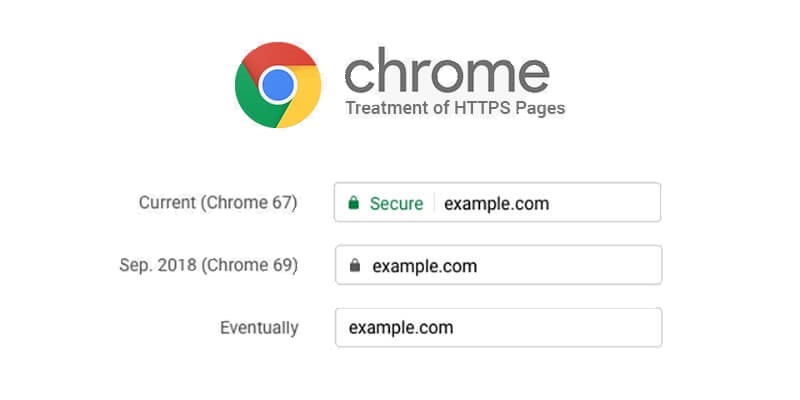
Or, the EV Name Badge/Green Address Bar

Both of these icons bespeak that the website is using HTTPS and that you lot accept a secure connection. If you run into either of these, your connectedness is secure and y'all are communicating privately with the website listed in the URL.
Remember, most secure connections volition take the padlock icon, merely some may also accept the Green Address Bar. Or rather, it used to be uniformly light-green. Nowadays, different browsers display the EV Name Badge in different ways.
The Green Address Bar/EV Name Bluecoat is just shown when a website is using a specific type of SSL certificate known every bit an Extended Validation (EV) SSL Certificate. This certificate allows a website to assert its identity and show information technology is operated by a real-world, legally incorporated company. Browsers give websites with EV SSL certificates preferential treatment by displaying the company proper name to the left of the URL. When you encounter an EV Proper name Bluecoat, you can relax—y'all're secure. The green accost bar cannot exist faked, it is un-impugnable proof of identity—and by extension trustworthiness.
The exact advent of EV name bluecoat varies by browser. Sometimes the proper noun is written in green, sometimes it is inside a green rectangle and sometimes it's not greenish at all. Hither are a few examples of how EV certificates await in pop browsers:
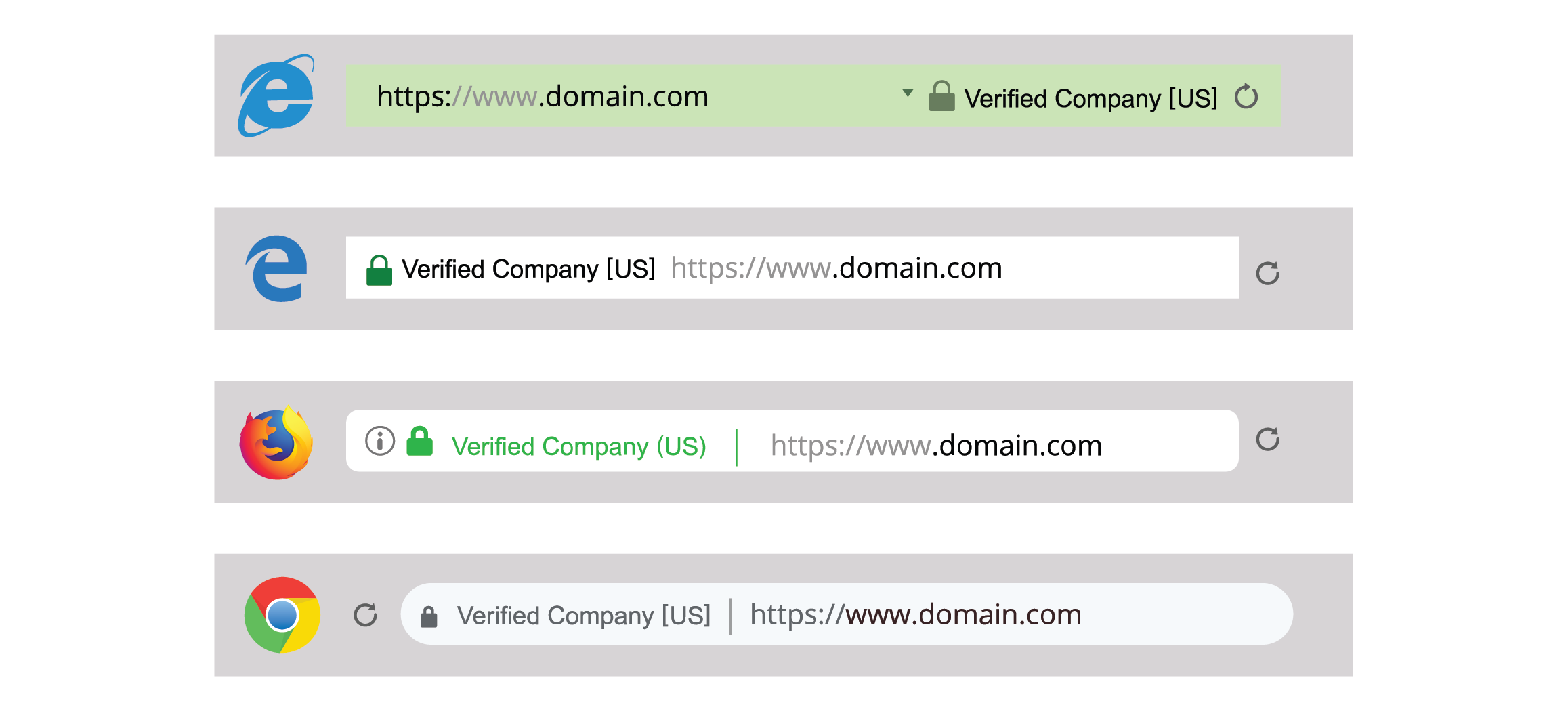
It'south possible for a URL to have HTTPS in information technology simply for the padlock icon not to appear correctly, also. This indicates that there is some security issue with the connection – normally mixed content, when a site is notwithstanding loading some assets that are HTTP – and represents a crusade for business organization. If this is the case, it'south all-time to assume you do non have a secure connectedness.

Y'all volition now encounter the "Non Secure" alarm on all websites that are beingness served via HTTP every bit of July of 2018, likewise. This will give yous an immediate visual indication that your connection is not secure.

At present, i more thing: A secure connection doesn't necessarily equate to a safe website. Lots of fake websites use free SSL certificates. Think of it like this:
- Y'all should just visit sites that use HTTPS
- Only because a site has HTTPS, doesn't mean yous can automatically trust information technology.
Simply because the connection is secure (which should be mandatory), you don't necessarily know who is on the other stop of that connectedness. Outside of Extended Validation SSL and the EV Name Badge, which can exist trusted on site, you'll demand to do a petty more sleuthing to make certain the site is legitimate. To verify a website's HTTPS connection, you lot can likewise try this SSL checker tool.
3. View Certificate Details
This one is a bit more advanced because it involves diving a bit deeper into your browser'southward carte du jour and that can be misleading if y'all don't accept a proper understanding of SSL.
If a website doesn't have the green address bar, the most that you tin tell from the presence of security connexion indicators is that your connexion is secure. That means no third party can eavesdrop and steal data. But every bit nosotros just discussed, it doesn't hateful you're prophylactic, though.
That's because y'all don't know who is on the other cease of the connection, yet.
Fortunately, that information might exist bachelor. Here'southward how to find it:
Most browsers (like Safari and Firefox) let you lot to view the document by clicking the padlock icon in the address bar.
For Firefox: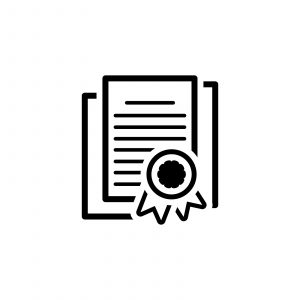
- Click the Padlock icon
- Click "More Information"
- Click "View Document"
For Safari:
- Click the Padlock icon
- Click "View Document"
For Chrome:
- Click the Three Dots icon to bring up the menu
- Under "More Tools" select "Developer Tools."
- Click on the Security tab
- Click "View Certificate."
-or- - Click the Padlock icon
- Click "View Certificate" (Google returned to making certificate details available past clicking the padlock last year)
When y'all click on the certificate information, you volition get all of the information the CA verified before it issued the document.
Once you have the certificate details open y'all want to wait for the following field: Subject.
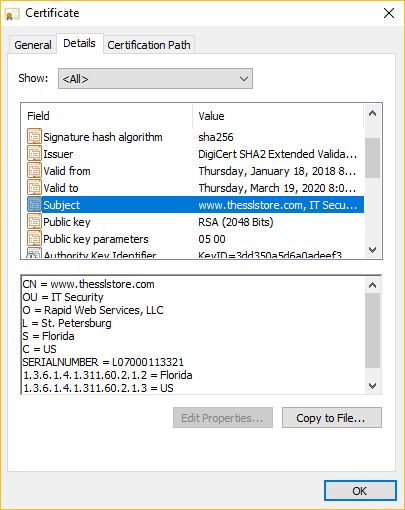
The Subject is the website or system that the document is representing. Depending on the blazon of certificate (DV, OV, or EV) you will run into different amounts of data in the Subject.
A DV certificate will merely have a domain name. An OV certificate will include limited company information (a name, a state/province and land). An EV will have detailed company information, such as an exact street address. You can recognize an EV certificate if the browser is displaying the EV Name Badge. Extended Validation offers the most information—that'southward why information technology has a special visual indicator.
If an system has an OV SSL certificate – which is recommended equally a baseline for e-commerce businesses, fiscal institutions, etc. – and then you volition be able to run into verified business details in the certificate data. Provided the website is registered to the right company, you're fine. You tin can probably trust this site.
If it doesn't, then you lot demand to exist careful.
There'southward also the possibility that this information isn't supplied at all. If that's the instance then the website only has a Domain Validated SSL certificate. This doesn't hateful y'all should automatically distrust the website, simply it does hateful yous demand to continue to be skeptical until the site can evidence its legitimacy.
4. Await for Trust Seals
When a company or organisation makes a substantial investment in their customers' security, they typically want a little bit of credit for it. That'southward one of several reasons that trust seals be. Y'all've probably seen more than than a few trust seals in your time on the internet. They look similar this:
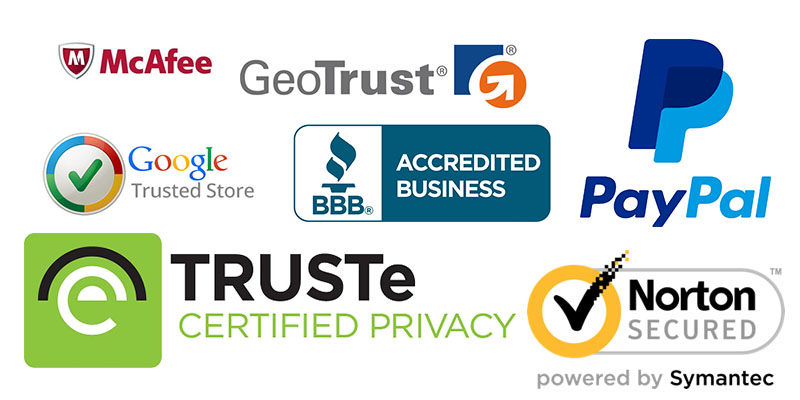
Trust seals are usually placed on homepages, login pages, and checkout pages. They're immediately recognizable and they remind visitors that they are secure on this folio. Information technology'south not dissimilar putting a sign in your 1000 or a sticker in your window that advertises your security organisation. People know what they mean as soon equally they see them.
Only did y'all know y'all tin can click on them too?
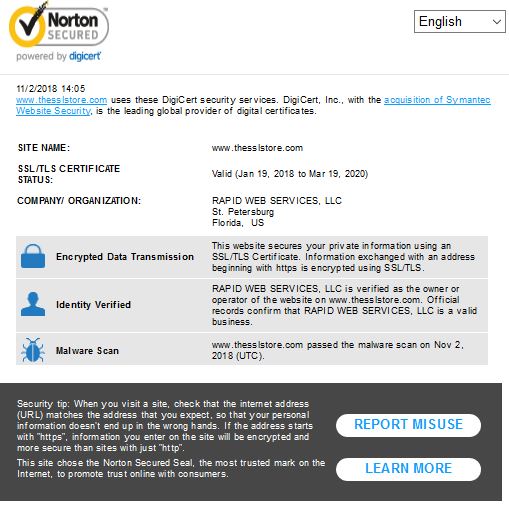
That's right, most SSL certificates come with trust seals that will display verified information when clicked on. This is important because it lets you know that the SSL certificate is in skilful standing and might also inform you lot of additional security mechanisms in place like malware scans or vulnerability assessments. SSL/TLS certificates aren't the just products that comes with site seals, either.
Merely, merely seeing the site seal isn't enough, it is essential that you click on it to verify information technology's legitimate.
5. Consult the Google Safe Browsing Transparency Report
This is the final resort, but information technology serves as a nice final safeguard: Google it. Literally. The Google Safe Browsing Transparency Written report allows you to copy and paste the URL into a field and information technology gives yous a report on whether or not y'all can trust that website. It's not especially fancy, nor does it avowal impressive aesthetics, but it certainly is an effective mode to determine whether or not a site is unsafe.
Granted, this isn't the finish-all, be-all. Google does occasionally miss stuff. But not for long. When you're as ubiquitous as Google, nothing escapes your view for long. Google's Safety Browsing service is amongst the best on the internet when information technology comes to keeping users safety. If you're always in doubt, Google it.
Bonus! You tin can acquire a lot from a Privacy Policy
Right at present, in 2018, people are every bit attuned to their privacy and data security equally they have always been. A big role of that stems from the litany of new privacy regulations that have being instituted the world over– regulations like GDPR. These efforts to legally require companies to safeguard our data and be more transparent have provided an additional, unforeseen benefit, likewise: information technology'south now a lot easier to tell a legitimate visitor or organization from a fraudster.
It starts with the Privacy Policy, no affair where y'all are — what jurisdiction — organizations are required to provide certain data in their privacy policies. The overnice office almost this information is y'all can check information technology, verify it and make sure that yous are dealing with real people and a real website.
Let'due south start with a elementary binary: is this a passable Privacy Policy? You may non exist a connoisseur of privacy pages just chances are you have seen enough of them to be able to tell a real one from something more than dubious. The easiest way to bank check is to look for actual specific information: names of officers or employees, addresses, means to arrive contact and participation in specific programs.
A adept example of this would exist the European union-U.s. and Swiss-U.s.a. Privacy Shield program run past the U.s.a. Department of Commerce, the Department of Transportation and the FTC. US companies that take partners in Europe are oftentimes required to certify themselves in order to comply with the European union'due south General Data Protection Regulation. The Privacy Shield has an official listing that y'all can bank check to verify an arrangement'south participation, too. Cheque that list. If you see the company there, you're set.

If they claim to exist certified and they're not, they're breaking the law past misrepresenting themselves, which should requite you break. Even if this is a legitimate website, is this the kind of outfit you want to requite your business organization to?
8 More Internet Tips to Help y'all Spot Fake or Fraudulent Websites
This side by side section might as well exist chosen our common sense section. That beingness said, you'd exist genuinely surprised how many people ignore this stuff on a regular basis. Here are viii more tips to help keep you safe online.
Trust Your Browser
The browsers are our portal to the net. We can simply go where they have u.s.a., and sometimes they don't desire to take united states certain places. Exercise yourself a favor and heed to them when they suggest y'all not go to a website. Whether it's Chrome or Firefox or fifty-fifty Edge or Safari – they all let y'all know when you're nearly to devious to somewhere unsavory. And this isn't just guesswork, either. This is based on data and user reports that clearly point a threat. So take that threat seriously: listen to your browser.
Bonus Tip: Despite bad advice from enough of other articles, NEVER disable your antivirus or drop your firewall. Ever.
Await for Bad English language
Proficient websites take pride in themselves. That means the graphics wait sharp, the spelling and grammer is on betoken and the entire experience feels streamlined and polished. If you're on a website that feels similar it was written by someone with a third-grade teaching – or past someone who doesn't speak English as a get-go language – yous may want to be a little flake wary. Especially if those mistakes announced on important pages.
Anybody makes the occasional mistakes—fifty-fifty big companies. Just at the point the mistakes become egregious y'all need to beware.
Look at the Contact United states of america Section
![]() Some other telltale sign when information technology comes to whether or not a website is fake or not tin be found on its "Contact Us" section. How much information is there? Is an address supplied? What near a phone number? Does that line actually connect to the company? The more data that is supplied, the more confident y'all should experience—provided information technology's really good data. If all they're giving you is an email accost or, worse, there's no contact information whatsoever—run.
Some other telltale sign when information technology comes to whether or not a website is fake or not tin be found on its "Contact Us" section. How much information is there? Is an address supplied? What near a phone number? Does that line actually connect to the company? The more data that is supplied, the more confident y'all should experience—provided information technology's really good data. If all they're giving you is an email accost or, worse, there's no contact information whatsoever—run.
And call back to verify the information. Google the address, maybe even bank check out street view. See if any employee that'due south listed has a LinkedIn profile. Practise a little homework.
Is there an Over-Abundance of Ads?
Ads are a fact of life. No matter where you go, you're going to encounter ads. Simply if you're on a website that is more ads than content, tread advisedly. If you have to click several links to get through intrusive popular-ups and redirects to accomplish the intended folio—you're on a website that is probably false or at least scamming. There's a fine line between UX and selling ads. When information technology's articulate that a website has no regard for that line, you need to be wary.
Bank check the Who.Is
This is another tip for advanced users.
If y'all really desire to know who is running a website in that location is a database called Who.Is that can tell you lot what email accost it'southward registered to. In that location are a number of free sites that allow you to check a website's official WHO.IS registration, though GDPR concerns have complicated admission lately.
A WHO.IS registration can tell you the possessor of a website and if it'south an individual or a visitor. If it's a visitor there will exist an "Organization" listed along with an address and telephone number. For an private, there will exist a "Name" listed along with an accost.
This tin can be an invaluable tool, especially when yous're dealing with brands. If you're at a website that claims to be owned by a large visitor but is registered to some address in some other country, there's a adept adventure yous're on a fake website.
Check the Shipping and Return Policy
Whatsoever legitimate e-commerce visitor is going to take a shipping and return policy, it's considered a best practice. So any website that purports to exist selling something only lacks this documentation is automatically suspect. Likewise, if you click the link and the policy looks flimsy or has been copy-and-pasted directly from another website, that's also suspect. Look, we're not telling you to read the whole thing – nor are we naïve plenty to believe you would – but a quick look should tell you all you need to know.
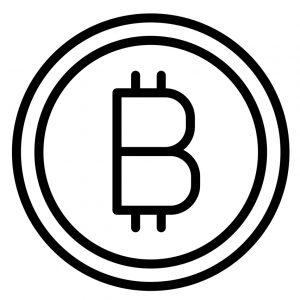 What forms of payment do they accept?
What forms of payment do they accept?
This is another tip that is more for e-commerce, just what forms of payment does the website offer to accept? About legitimate companies volition take major credit cards and typically accept a couple of non-payment menu options, besides. If a website is asking y'all to ship money to a random PayPal address, wire it by Western Union, pay in iTunes gift cards or only deals in cryptocurrency, that should send up a red flag. The majority of the time, those methods are done to avoid scrutiny and ensure that a transaction can't be reversed. Remember, a legitimate website would have nothing to hide and likely wouldn't participate in this kind of suspicious business practise.
Cheque for a Digital Footprint
The beautiful thing about the cyberspace is that zippo exists in a vacuum. Chances are other people have had experiences with this visitor and – good or bad – they take shared those experiences somewhere. With but a tiny bit of digging, you can probably figure out if a website is fake based on reviews alone. Google the name of the site along with "+ reviews." Check with the Better Business Agency, or one of the myriad scam sites that exist to protect consumers. Just expect a little. The internet may not be the best at telling you whether something is good, simply it tin can definitely tell you when something is bad. And all it takes to find out is almost three minutes and Google.
Where to Study Fake or Fraudulent Websites
We encourage you to report simulated websites. Information technology'southward good for the internet, it's good for your inner chi and if you're piddling—it gives you that skillful tingly feeling. Hither's where to report malicious websites:
- Google – Safe Browsing
- Mozilla – Protect the Trick
Microsoft gives its users an opportunity to written report malicious sites within its browsers. To practise this become to the Tools/Safety menu, select Phishing Filter/SmartScreen Filter and click "Report Dangerous Website."
A Final Word
Information technology's possible that after reading this guide yous're feeling a little uneasy. That's non the point we were trying to make. The net is an amazing identify and you lot tin use it for a countless number of worthwhile activities. But, much similar anything else in life, there are some dangers. Don't let that dissuade you, equally long every bit you stay vigilant you're non likely to run into many problems.
Just stay on the beaten path, trust websites that have made an investment in authentication and be careful if you ever get the sense that something might be off.
Re-Hashed is a regular weekend feature at Hashed Out where nosotros dust off i of our favorite posts from yesteryear, requite it a little love and share it with you over again. Today we discuss a topic that's relevant to everyone: web safety. This commodity has been updated to reflect the current security climate in 2018.

Source: https://www.thesslstore.com/blog/5-ways-to-determine-if-a-website-is-fake-fraudulent-or-a-scam/
Posted by: mcphersonpinge1991.blogspot.com

0 Response to "Can My Ecommerce Website Get Cheated With Fake Paypal Money"
Post a Comment